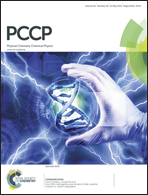Theoretical insight into chlorine adsorption on the Fe(100) surface
Abstract
This study represents a detailed DFT periodic-slab study on the interaction between atomic chlorine and the Fe(100) surface. Energetic and structural parameters are calculated for a wide range of coverages corresponding to top, bridge and hollow pure on-surface adsorptions. Calculated chemisorbed energies are found to increase gradually with the degree of coverage. Formation of iron chlorides via substitutional adsorption is predicted to be not feasible in view of the calculated chemisorption energies. This finding is in line with earlier experimental measurements with regard to the absence of chlorine diffusion into bulk Fe. Sublimation energies for FeCl2 and FeCl3 are estimated and discussed to elucidate the fate of the chlorine–iron thin layer. A stability temperature–pressure diagram is constructed for a wide range of chlorine chemical potentials to mimic real operational conditions.


 Please wait while we load your content...
Please wait while we load your content...